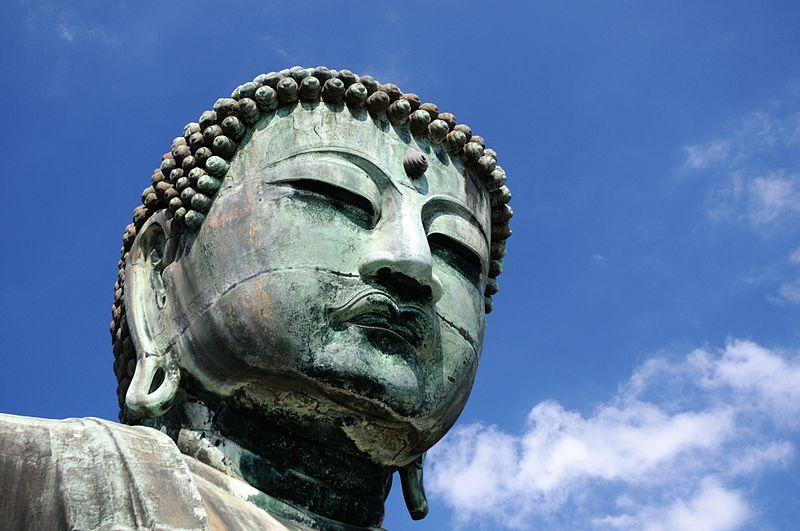
Two Kinds of Nature
As a Pure Land, the nature of the Land of Bliss is pure in every sense of the word. As declared by Master Tanluan, purity is its overall nature, because the Land of Bliss is adorned with the real and substantial merits and virtues accomplished by Amitabha Buddha with pure karma.
In other words, the nature of the Pure Land is:
1. Not unreal and not hypothetical
2. Not repeated in the cycle of rebirth
3. Not changing
This means it is a land of great purity permeated with ultimate peace and joy, as stated by Master Tanluan in his Commentary on the Treatise of Rebirth. Moreover, he indicated that the nature of purity in the Pure Land is non-destructive and non-contaminated.
These are abstract concepts in comparison with our Saha World. All phenomena in samsara are destructive and contaminated, the exact opposite of the Pure Land.
Our world is a result of the flawed karma accumulated by sentient beings in their past lives. At the same time, the merits and virtues attained by ordinary beings are unreal and non-substantial, and cannot guarantee liberation. Our world has three characteristics:
1. Unreal and hypothetical
2. Repeated in a cycle of rebirth
3. Ever-changing
When the bodhisattva Vasubandhu wrote the Treatise of Rebirth, he declared his sincere aspiration to be reborn in the Land of Bliss, also known as the Western Pure Land, because he recognized its real nature based on the teachings of the Pure Land sutras spoken by Shakyamuni Buddha.
What is meant by “real and substantial merits and virtues”? And what is meant by “unreal and non-substantial merits and virtues”?
Two Kinds of Merits and Virtues
Why are the Pure Land and the Saha World different in nature? It is because they are produced by different kinds of merits and virtues. As Master Tanluan explains in the Commentary on the Treatise of Rebirth:
“There are two kinds of merits and virtues:
1. One kind originates from the flawed mind, which does not accord with the Dharma Nature. These are the celestial and human virtues of ordinary beings, resulting in celestial and human rewards. Whether they are causes or effects, both are inverted, unreal, and hypothetical. These are so-called ‘non-substantial merits and virtues.’
2. The other comes from the pure karma of the bodhisattva’s wisdom. All achievements in Buddhahood are adorned with the real merits created by this pure karma. They accord with the Dharma Nature to ‘enter’ the pure form or mark. They are not inverted, not unreal, and not hypothetical. They are therefore called ‘substantial merit and virtues.’
What is meant by ‘not inverted’? It is because they are in harmony with the Dharma Nature, and accord with the Two Truths [Ultimate Truth and Worldly Truth].
What is meant by ‘not unreal and not hypothetical’? It is because they embrace sentient beings to ‘enter’ the ultimate purity.”
“Not inverted” refers to the supreme wisdom of the Buddha, and “not unreal and not hypothetical” refers to his unconditional compassion. “To accord with the Dharma Nature” means to be natural, with no discrimination or deliberation. Without a single thought of self, the Buddha embraces all sentient beings and leads them to ultimate liberation. That is why the Pure Land’s merits and virtues are real and substantial.
Our Saha World is produced by ordinary beings’ collective karma, which is subject to the Law of Causal Conditions. That means all phenomena are impermanent and empty in nature. All physical and mental existence possesses the three characteristics of impermanence (anitya), selflessness (anatman), and suffering (duhkha).
The Land of Bliss is produced by the pure karma of Amitabha Buddha’s wisdom, which is the outcome of accumulated substantial merits and virtues. The bodhisattva Dharmakara attained perfect and complete Buddhahood through diligent and prolonged bodhisattva practices. Master Tanluan wrote that Amitabha Buddha’s Reward Body (sambhogakaya), the Pure Land, and even the beings reborn there in lotus buds are manifestations of his cosmic majesty.
The Land of Bliss is a Realm of Unconditioned Nirvana
In explaining this passage about the practice for rebirth in the Pure Land in the Amitabha Sutra, Master Shandao wrote a verse in his In Praise of Dharma Practices indicating that the Land of Bliss is a realm of unconditioned nirvana.
“Unconditioned” means intrinsic and natural, non-differentiated and absolute, while “conditioned” means deliberate and artificial, differentiated and relative. As an unconditioned realm it transcends space and time, has no deliberate action, no birth and no death, and is not differentiated but equal, not relative but absolute. Only such a domain can be described as unconditioned nirvana, a Buddha realm.
In the Infinite Life Sutra there is a paragraph describing the bodily appearance of inhabitants, which states:
That Buddha-land, like the realm of unconditioned nirvana, is pure and serene, resplendent and blissful. The hearers, bodhisattvas, heavenly beings, and humans there have lofty and brilliant wisdom, and are masters of supramundane powers. They are all of one form, without any differences, but are called ‘heavenly beings’ and ‘humans’ simply by analogy with the states of existence in other worlds. They are of noble and majestic countenance, unequaled in all the worlds, and their appearance is superb, unmatched by any being, heavenly or human. They are all endowed with bodies of Naturalness, Emptiness, and Infinity.
It is interesting to note that the inhabitants are all of one form, without any differences, but are called “heavenly beings” and “humans” simply by analogy with the states of existence in other worlds. How does this happen and why is it so? It seems that differentiating between the beings of this paradise would be impossible. We cannot take an analytical approach to realizing the Land of Bliss as the logical thinking of our discriminating mind cannot access it. However, if we were there, we would realize everything at once.
The situation is similar to eating a banana. If someone has not previously seen or eaten a banana, they have no way to imagine the taste, the texture, the smell, and so on. Even if an eloquent wordsmith tries hard to describe the taste using various analogies, he cannot convey the exact idea to someone who has never eaten one. However, if he offers them a bite, they will know immediately what he is talking about. It is the same with the Land of Bliss. Moreover, we will be born with supramundane abilities and wisdom without needing to acquire them, as they are innate to someone born in the Land of Bliss.
Master Tanluan explained this in his Commentary on the Treatise of Rebirth:
“Beings and their dependants in the world of assorted births that are born, whether by womb, by egg, by moisture or by manifestation, are of different levels in between happiness and suffering, because of their assorted karma. However, in the Land of Peace and Joy, all beings are born by manifestation in the lotus flower of Amitabha Buddha with his pure and perfect enlightenment. This is because all the beings are born in the same way with a single cause: Amitabha-recitation, and no other causes or virtuous ways.”
The Land of Bliss is a realm of unconditioned nirvana. Thus, in his exegesis of Pure Land sutras, Master Shandao says: “The Land of Bliss is a realm of unconditioned nirvana. It is hard to gain rebirth there by undertaking the circumstantial miscellaneous practices [of the Five Precepts, Ten Good Actions, and other myriad virtuous practices].”In this respect, we should know why Amitabha’s merits and virtues can lead us to rebirth in the Pure Land. Amitabha assures our rebirth in the Land of Bliss as long as we recite exclusively his name.






